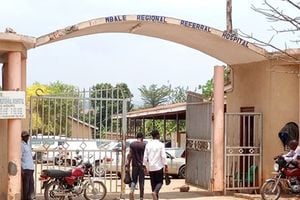
The main gate of Mbale Regional Referral Hospital. PHOTO/ YAHUDU KITUNZI
The government has named Mbale, Arua, Hoima, and Mengo hospitals as the best-performing facilities in terms of care in the regional referral and large private not-for-profit hospitals category.
This information is contained in the health sub-programme performance report for the 2023/2024 financial year (FY), released during the Annual Health Sub-Programme Joint Review Mission in Kampala on Wednesday.
According to the reports for the FY2023/2024 and FY2022/2023, Mbale Regional Referral Hospital (RRH) maintained its ranking in both years, while Arua RRH improved from the fifth position to the second position.
We also found that Hoima RRH dropped from the second position to the third position while Mengo Hospital, a Private Not-For-Profit (PNFP) facility in Kampala, showed one of the most significant improvements from the 16th position to the fourth position.
Also concerning is that St Mary’s Hospital Lacor dropped from the third position in the previous financial year to the 14th position and Masaka RRH also dropped from the fourth position to the 21st position, the second last.
“Given the similarity of the patient profile in regional referral and large PNFP hospitals, a relative ranking has been produced based on the following parameters: outputs 60 percent; quality 20 percent, and efficiency 20 percent,” the new report reads.
It adds: “The best performing hospital for a given indicator was given a maximum score for that indicator and other hospitals scored relative to it. The hospitals were then ranked relative to their total scores. Mbale RRH with a total score of 64.8 percent was the best performing RRH followed by Arua RRH at 49.7 percent and Hoima RRH at 47.1 percent.”
According to the report, Mbale RRH had 58,169 admissions, making it the facility with the highest admissions among the 21 health facilities assessed. Mbarara RRH which was ranked 13th, also had one of the highest admissions, 42,450.
In terms of deaths, there are 3,750 deaths from Mbale RRH, which is 6.4 percent of the patients admitted. While in Mbarara RRH there were 3,892 deaths, which is 9.2 percent of patients admitted –higher than the average death rates in Mbale RRH.
Dr Sam Kamba, the senior planner at the ministry’s Department of Planning, said when they are ranking facilities where many patients are referred to, when the facilities get a large number of patients, their ranking improves because they will have very high output.
Asked about the concern that private health facilities and clinics tend to refer patients to public hospitals when the patient is about to die, Dr Kamba said it is not an excuse for poor performance in RRHs.
“As the government, we are responsible for all individuals. We cannot say you are too sick for the government hospitals,” he said, adding that they have created intensive care units (ICUs) in each facility.
“We cannot say the patient was sent to us late. It is us who should be prepared to take care of that patient and the [Health] minister [Dr Jane Ruth Aceng] has really focused on improving emergency medical services including ICUs,” he argued.
However, recent reports by this publication indicate that some facilities had not yet installed ICU equipment or the facilities were not operational because of limited resources like Masaka hospital where management told this publication in May that the ICU equipment has remained idle for three years after it was delivered because they lack a facility to house the equipment.
There have also been issues of limited supply of drugs, lack of reagents for performing tests and absenteeism of health personnel, partly because of low funding and management gaps.
Link performance to funding
Dr Sarah Byakika Kyeyamwa, the commissioner for planning, financing and policy at the Health ministry, while commenting on the new report, indicated that the performance should be used as a determinant for funding for each facility, meaning poor-performing facilities may get lower funding, whichcould have impact on access to services by patients.
Dr Byakika said the health sub-programme has on average been receiving about 7.5 percent of the total national budget, the amount she said is low when compared to the earlier commitment by the government that it would give at least 15 percent of the national budget to health sub-programme.
Dr Aceng urged the public to prevent disease as the country pushes for increased domestic funding and a one-budget approach for both development partners and the government.
“$3.1 (about Shs11,300) is allocated for your medicine [per financial year]. If you know that that is the allocation, why don’t you prevent...why don’t we eat healthy? One in four people has hypertension,” she said.
TOP TEN HOSPITALS
•Mbale RRH
• Arua RRH
•Hoima RRH
•Mengo Hospital
• Rubaga Hospital
•Jinja RRH
•Gulu RRH
•St Kizito Matany Hospital
•St Francis Nsambya Hospital
•Fort Portal RR






